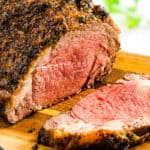Ribeye Roast
Our boneless prime rib roast is a succulent and flavorful dish that will make your guests happy they came. It’s perfect for special occasions.
Servings 4
Calories 1433
Ingredients
- 4 lbs ribeye roast boneless prime rib, forerib, rib of beef, or standing rib roast
- 3 tablespoons Kosher Salt
- 3 cloves garlic minced
- 4 tablespoons Dijon mustard or softened butter
- ¼ cup paprika
- 1 tablespoon brown sugar
- ¼ cup ground black pepper
- 1 tablespoon fresh parsley or thyme, chopped (or 1 teaspoon herbes de Provence)
Instructions
- If the roast has a fat cap, using a sharp knife, cut through the fat in a 1-inch crosshatch pattern being careful not to cut into meat).
- Rub the salt over the entire surface of the roast. Transfer to a large plate and refrigerate, uncovered, for 45 minutes to 2 days.
- Remove the roast from the refrigerator and let stand at room temperature for 2 hours.
- Preheat oven to 500°F/260°C.
- Mix the garlic and mustard together in a small bowl and set aside.
- Mix the paprika, brown sugar, and black pepper in another bowl and set aside.
- Pat the roast dry with paper towels. Spread the garlic and mustard mixture over the top and sides of the roast. Sprinkle the paprika, brown sugar, and pepper blend over the entire surface of the roast.
- Apply a thin layer of the mustard mixture to the roast covering all sides.
- Apply the rub and herbs, covering all sides.
- Roast in the oven for 15 minutes.
- After 15 minutes, reduce the temperature to 325°F/163°C and roast for a further 15 to 18 minutes per pound (60 to 75 minutes for a 4lb roast). In the thickest part of the roast, a meat thermometer should register 130 to 135°F (54-57°C) for medium-rare or 135 to 140°F (57 to 60°C) for medium.
- Remove from oven, tent with foil, and let stand for at least 15 to 20 minutes. Slice the meat across the grain to the thickness you prefer.
Notes
- During resting time, the internal temperature will rise about 5 to 10 degrees. The rib eye roast should be removed 5-10 degrees before it's done.
- If you’re buying a prime rib with the bone, just ask the butcher to remove it and use it as your baking rack in the pan.
- If Using a Convection Oven: Convection ovens can reduce cooking times by up to 25%. Additionally, the convection oven can dry your Roast and cook it too much. Keep a careful eye on the Roast and use a cooking thermometer to determine when it is done.
- If you plan to make gravy with the drippings, be sure to use a roasting rack in your pan so you can let it rest in the rack while you make the gravy.
- High Altitude Roasting: Use the instructed time and temperature, as altitude changes do not affect oven temperatures but allow for additional cooking time. Use a meat thermometer to measure internal temperatures.
- If you are not a fan of mustard, replace it with butter for the same result.
- Basting is not necessary, but if you want to baste your Roast every 30 minutes with the dripping from the pan.
Nutrition
Calories: 1433 | Carbohydrates: 18g | Protein: 65g | Fat: 123g | Saturated Fat: 51g | Polyunsaturated Fat: 5g | Monounsaturated Fat: 53g | Trans Fat: 0.003g | Cholesterol: 274mg | Sodium: 5609mg | Potassium: 1395mg | Fiber: 7g | Sugar: 4g | Vitamin A: 3501IU | Vitamin C: 2mg | Calcium: 136mg | Iron: 10mg
